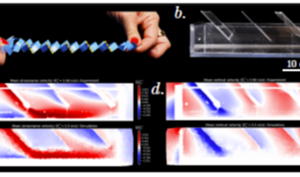
In urban environments facing rising temperatures, pollutants, and airborne viruses, we need spaces that can thermally regulate and e ffectively ventilate, all with minimal energy input. To address the needs for shade and ventilation in cities simultaneously, we propose a solution based on kirigami, the ancient Japanese art of paper cutting. Adding cuts to a thin sheet frees pore-like sections to buckle out-of-plane and rotate when the sheet is stretched in one direction. This mechanism could be used to steer wind into spaces with stagnant air to improve air fi ltration,while also modulating sunlight to improve thermal comfort, thus reducing energy needs for cooling. Kirigami o ffers a widely customizable, zero-waste design, which is easy to deploy and adaptively actuate. The aim of this research is to develop a framework for designing kirgami structures that can be tuned to optimize shading, ventilation, or a combination of the two.